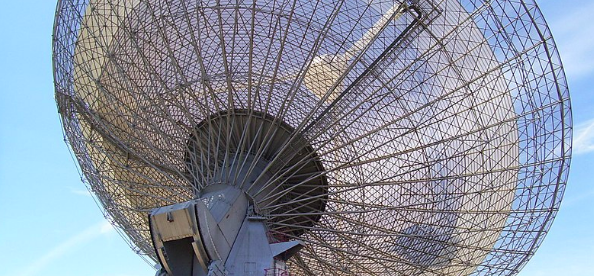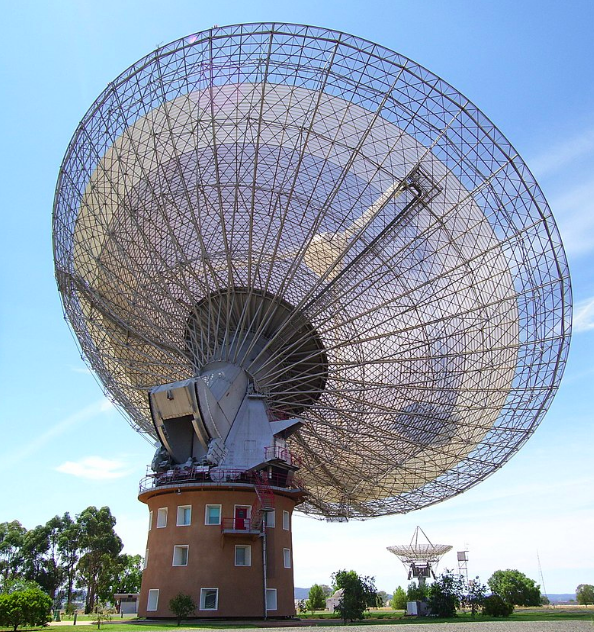The Aliens in the Cupboard


Pictured above is something called a “radio telescope,” and it’s a really, really big one. Colloquially called “The Dish,” the Parkes Observatory sits in New South Wales, Australia, listening to the skies above. The Dish is so good at collecting information from off our planet that you’ve probably seen footage it has collected. When Apollo 11 landed on the moon in 1969, NASA began its broadcast of the events using feeds from a variety of radio telescopes around the world. But as Smithsonian notes, “just before the nine-minute-mark, as Armstrong starts to explore the lunar surface (and about ten minutes before Aldrin comes down the ladder), Houston switched over to the superior images from the enormous Parkes dish—and remained on Parkes for the rest of the two-and-a-half-hour lunar walkabout.” It’s safe to say that The Dish is good at what it does.
So when The Dish picked up some strange, potentially extra-terrestrial radio signals in 1998, researchers took it seriously. They probably shouldn’t have.
In 2007, Duncan Lorimer, a professor of astronomy at West Virginia University, discovered what is now known as a “fast radio burst” or “FRB” The name mostly describes the phenomenon — a short (often less than a millisecond) pulse of radio waves “caused by some high-energy astrophysical process not yet understood” as summed up on Wikipedia. Stellar decay, radiation from black holes, and the like are all very possible explanations. But intelligent extra-terrestrial life can’t be ruled out. And if we were to see some repeated, but erratic signals, that could suggest that there are aliens out there.
To better understand FRBs, observatories began reviewing their old data to see if they missed some of these really short bursts. And it turned out that Parkes had, indeed, detected some FRBs. From 1998 to 2002, The Dish’s logs showed eleven such events — a lot, by any measure, and with no discernable pattern. And to make matters worse, as The Conversation explained, the fact that these burst happened years ago and went unnoticed at the time “[made] it difficult to trace back the source of the odd pulses.” So researchers gave the pulses a name — “perytons,” aptly named for a mythical creature from a 1950s fiction novel — and kept an eye out for future emissions.
Researchers knew pretty early on that the signal wasn’t coming from the great beyond, so aliens weren’t a likely culprit (unless they were already in orbit!!!). As National Geographic explained, “despite mimicking a deep space signal, [perytons] produced by something that’s somewhere near Earth. Astronomers knew that perytons were locally grown because the signals simultaneously showed up in multiple viewing fields rather than arriving from a single point, as distant signals do.” Absent a Close Encounters of the Third Kind moment, the FRB likely had a down-to-earth explanation. And it turned out it did: popcorn.
Okay, maybe cold pizza. Or a frozen meal. Or… well, you get the idea. The culprit was coming from the staff breakroom at the Observatory, and specifically, the microwave oven.
Most of the staff that works at Parkes does so remotely — one doesn’t have to be in the building to read through the data collected by the big dish. But there are some people who attend to the site at times, and they have to eat. And at times, they’ll use the microwave.
Microwave ovens aren’t supposed to emit interference, though — while it’s probably not a great idea to stand in front of one while in operation, it’s probably safe to do so absent some sort of weird malfunction. And if the microwave were malfunctioning, The Dish wouldn’t be picking up FRBs — we’d be seeing elongated disruptions. (If it takes two minutes to reheat coffee, you’d see a two-minute burst.) So at first, researchers disregarded the microwave oven as the cause of the “signal.”
But in 2015, they figured out the missing part of the explanation. One of the PhD students investigating the origins of the perytons, Emily Petroff, told the press that “it turns out that you can generate these particular local signals by opening the door of the microwave to stop the microwave.” Basically, when you hit the stop button or when the microwave timer runs to zero, the “signals” never escape the microwave’s cage. But if you hit the door open button, there’s a very, very brief moment where the radio waves are still present and the door is slightly ajar. And per Petroff, “that produces these weird bursts that we’re seeing at Parkes.”
The good news is that these FRBs probably aren’t significant enough to cause harm to you if you (like everyone) use the open-door button to stop the microwave from warming your food. The bad news? It’s also not evidence of aliens.
Bonus fact: Microwaving food takes up electricity, of course. But because you’re only using that power when you’re actually cooking, and because things cook/reheat so quickly, you end up using a lot less power than you’d think, at least over the course of a full day. Because the oven itself is usually idle, as the Economist observes, “a typical microwave oven consumes more electricity powering its digital clock than it does heating food.”
From the Archives: Zapped Chocolate: How the microwave oven was discovered. Also, why you shouldn’t microwave a mostly-cut grape.
